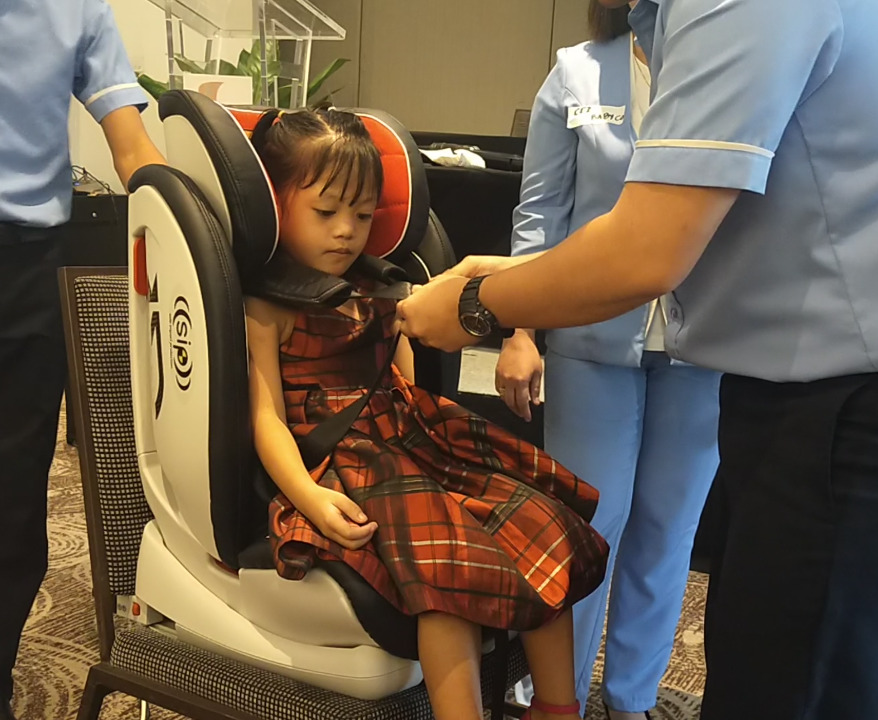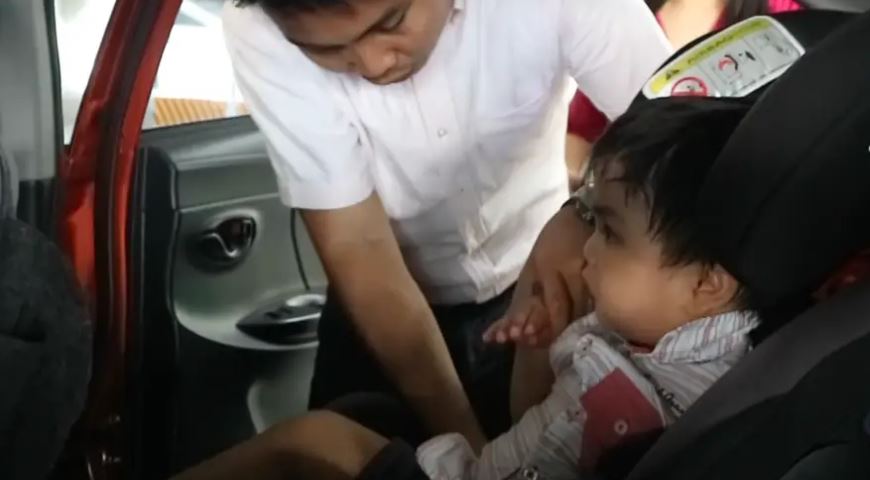
Maria* is well aware of the importance of a child car seat. She had, after all, bought one for her son when he was an infant. But it was taking up too much space in their small car so she gave it away.
“I thought, since my first two children survived riding cars without car seats, my youngest wouldn’t need it,” she said. Her son is now two years old.
But listening to safety advocates and government officials during a road safety forum in Davao City on Feb. 27, the 35-year-old working mom has realized her mistake. “I felt it was the right decision at that time, but it was wrong.”
“Even if it is crowded at the back, I will be sure to buy a car seat again for my youngest child. We cannot compromise our child’s safety,” she said in an interview after advocates at the public forum urged families to invest in child restraint systems (CRS) for their children’s protection.
‘Buckle Up, Kids! Keeping Kids Safe on the Road’ organized by IDEALS (Initiatives for Dialogue and Empowerment through Alternative Legal Services) was intended to raise awareness on the use of car seats in private vehicles, as provided for in RA 11229 or the Child Safety in Motor Vehicles Act that was signed in February 2019.
The law mandates the use of CRS by infants and children 12 years and below while being transported in private motor vehicles. It also prohibits kids from sitting in front of a vehicle, unless the child is four feet and eleven inches (4’11) in height, but he or she should be properly secured using a regular seat belt.
Karen Bardinas, a journalism student intern who was also at the forum, became more convinced of the importance of installing a car seat as she recalled an incident when she drove her car with her four-year-old niece on board.
“I remember driving with my niece and when I had to suddenly halt, my niece fell to the floor of the car. It happened when the (traffic) light suddenly turned red.”
“I think car seats are important because we don’t know when (crashes), even sudden stops, can happen. We shouldn’t risk the safety of children,” she said.
But not all at the public forum were completely sold on the idea.
Another mother who works in a government office questioned the need to mandate car seats when other road safety laws can address child safety concerns.
“Why is there a need to implement a car seat law for private car users with children when we can better practice existing road safety laws, such as speed management?” she asked.
This was the same argument posed by a local traffic enforcement officer who said that speed limits in Davao City are properly observed, hence crashes are rare and a car seat law is not seen as a priority.
Humans make mistakes
Lawyer Evita Ricafort, who helped craft the implementing rules and regulations (IRR) of the law, explained the rationale behind the law. She said: “Humans make mistakes, which is why we need to address all possible holes in existing laws.”
Ricafort, policy adviser of Imagine Law, a public interest law organization, was referring to the ‘safe systems approach’ – a road safety strategy that acknowledges that people make mistakes and some crashes are inevitable, but they should not injure or kill.
The approach also posits that road safety is a shared responsibility among road designers, policy makers, vehicles manufacturers, motorists, pedestrians, drivers, enforcement officers and other stakeholders to achieve safety outcomes.
“The objective of the law is to keep children safe on the roads. No matter how many training sessions or how improved our licensing system is, we will continue to make mistakes on the road, which is why we need measures like this to address the possibility of a road crash,” she said during the forum.
The World Health Organization (WHO) says child restraints are highly effective in reducing injury and death to child occupants as they keep kids from being thrown against the car interior in the event of crash or sudden stop.
If correctly installed and used, these devices reduce deaths among infants by about 70 percent and up to 80 percent among small children, it says.
RA 11229 was signed by President Rodrigo Duterte in February last year and its implementing rules and regulations were approved and signed last December. While the law officially took effect last month, mandatory compliance with the CRS law will only start in February 2021.
The one-year transition period will allow concerned government agencies to prepare for its implementation. This includes the nationwide training by the Land Transportation Office to build the capacity of law enforcers in implementing rules and regulations.
The Department of Trade and Industry (DTI) will have to develop safety product standards for CRS that will be manufactured, sold, distributed and sold in the country based on international standards, specifically United Nations Regulations 44 and 129.
Quality car seats
Rosemarie Rino of the DTI Bureau of Product Standards says their office is still working on the regulations for the product certification of child safety seats.
“As of now, car seats being sold do not have the DTI stickers. We will have to recognize testing reports from other countries,” she said, referring to imported CRS distributed locally, while adding that those who want to buy the safety devices now can do so but they should make sure they purchase quality car seats.
![[Left to right: Certified Bureau of Product Standards (BPS) mark and Import Commodity Clearance (ICC) stickers.] These assure consumers that products conform to the relevant Philippine National Standards . Photo from DTI.](https://verafiles.org/wp-content/uploads/2022/05/4363.png)
“You can check if it’s from a reputable dealer or reputable seller of CRS. You can also conduct a visual inspection of the seat, if it could be installed properly,” she added.
Once regulations are available, those with existing car seats that were purchased before the law was approved can have these checked at the LTO to see if they comply with the law.
“The LTO will issue a certificate to signify that the car seat passes the standard,” said LTO Field Enforcement Officer Atty. Roberto Valera.
The agency will also draw up rules on the accreditation of fitting stations and develop a training program for station operators who will be providing assistance to motorists in installing car seats and anchorage systems on their vehicles.
“We need time for the market to catch up, to ensure we have sufficient supply of these devices. We also need time for the public to learn, to educate themselves on how to use and install the CRS,” said Ricafort.
Philippine National Police Highway Patrol Group officer Oliver Tanseco assures that child passengers “shall not be subjected to any form of distress, as it is stated in the IRR.”
“It is not the child that will be subjected to apprehension, it is the driver. That’s why we have this one year period because it is a joint effort, not only of law enforcers, but also agencies … to educate the motorists and the parents themselves on the importance of the law,” he said.
“No parent should question the law because its objective is for the safety and protection of their loved ones, their children,” Tanseco added.

The CRS law is the latest intervention in the country to address road safety concerns or what the WHO) calls safety risk factors. These are speed, drink-driving, riding a motorcycle without a helmet, and travelling on the road without a seat belt.
With the CRS law, the Philippines now has all the necessary measures to help ensure safe practices on the road.
RA 11229 does not cover public utility vehicles such as taxis, vans, school buses and regular passenger buses but the Department of Transportation (DOTr) will be conducting a feasibility study to determine if it should require public transport to adopt CRS use.
If not feasible, the DOTr will recommend to Congress the necessary legislative measures for the safe and secure transportation of children in public utility vehicles.
*not her real name




